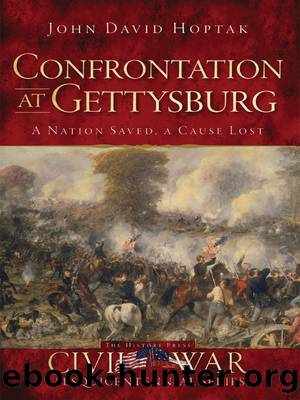Confrontation at Gettysburg by John David Hoptak

Author:John David Hoptak
Language: eng
Format: epub
Publisher: Arcadia Publishing
Published: 2012-01-15T00:00:00+00:00
H.A. Ogdenâs dramatic rendering of General James Longstreet overseeing his divisionsâ attacks on July 2 at Gettysburg. Library of Congress.
One South Carolinian remembered that the Union shells âwere cutting off the arms, legs and heads of our men, cutting them in two, and exploding in their bodies, tearing them to mincement.â Yet in the face of this destructive fire, the three South Carolina units pressed on, drawing ever nearer to the largely unsupported line of Union guns. But just at the moment it seemed that these men might overrun the cannons, there occurred a tragic miscommunication of ordersâall too common on both sides that dayâthat brought their attack to an abrupt and bloody end.
Kershaw had yelled out orders for the soldiers of his right wing to shift farther to their right in order to better close up with Andersonâs men in Roseâs Woods. Somehow, this order was also conveyed to the soldiers of his left wing, who then turned to their right and began bearing down easterly toward Stony Hill. This change in direction exposed their left flank to the devastating artillery fire, and the South Carolinians crumbled. As Kershaw later famously wrote, â[H]undreds of the bravest and best men of Carolina fell, victims of this fatal blunder.â But this fatal blunder did have one unintended consequence, one that led to the unraveling of the Union line in the Wheatfield.
After Vincentâs brigade had peeled away from the head of his divisionâs columnâgoing on to earn great glory on the slopes of Little Round TopâGeneral James Barnes led Colonel William Tiltonâs and Colonel Jacob Sweitzerâs brigades toward the Wheatfield. The 1,600 men of these two brigades arrived on Stony Hill just in time to help repulse Tige Andersonâs first attack, but their position on that small, tree-covered rise of ground greatly troubled both Barnes and Colonel Tilton. There was a large gap between Tiltonâs right flank on Stony Hill and Grahamâs men in the Peach Orchard, covered only by a thin line of skirmishers and by those cannons lined up along the Wheatfield Road to their right-rear. Making matters worse for Tilton, following the repulse of Andersonâs first attack, the 8th New Jersey and 115th Pennsylvaniaâtwo of Burlingâs regimentsâwithdrew from their positions in front of Stony Hill, mistakenly believing that they were being relieved, which, in turn, forced De Trobriand to spread his line ever thinner.
Then, surging forward once more through the trees came Tige Andersonâs indefatigable Georgians, joined now by Kershawâs South Carolinians, advancing to their left, from around the Rose farm and toward Tiltonâs line on Stony Hill. âShot and shell raged terrifically,â recalled a soldier of the 118th Pennsylvania, while â[t]he familiar piercing rebel yellâ¦dominated the uproar.â The Georgians and South Carolinians struck hard, but De Trobriandâs and Tiltonâs men held firm, and this second Confederate attack was brought to a standstill. Andersonâs men limped back into the trees, while Kershawâs men fell back toward the Rose farm. Yet while Kershaw looked around for support, the situation to his front was about to change.
Download
This site does not store any files on its server. We only index and link to content provided by other sites. Please contact the content providers to delete copyright contents if any and email us, we'll remove relevant links or contents immediately.
In Cold Blood by Truman Capote(3306)
Steve Jobs by Walter Isaacson(2830)
The Innovators: How a Group of Hackers, Geniuses, and Geeks Created the Digital Revolution by Walter Isaacson(2830)
All the President's Men by Carl Bernstein & Bob Woodward(2326)
Lonely Planet New York City by Lonely Planet(2170)
And the Band Played On by Randy Shilts(2127)
The Room Where It Happened by John Bolton;(2102)
The Poisoner's Handbook by Deborah Blum(2089)
The Murder of Marilyn Monroe by Jay Margolis(2057)
The Innovators by Walter Isaacson(2052)
Lincoln by David Herbert Donald(1943)
A Colony in a Nation by Chris Hayes(1880)
Under the Banner of Heaven: A Story of Violent Faith by Jon Krakauer(1746)
Amelia Earhart by Doris L. Rich(1647)
The Unsettlers by Mark Sundeen(1642)
Birdmen by Lawrence Goldstone(1618)
Being George Washington by Beck Glenn(1611)
Dirt by Bill Buford(1609)
Zeitoun by Dave Eggers(1588)
